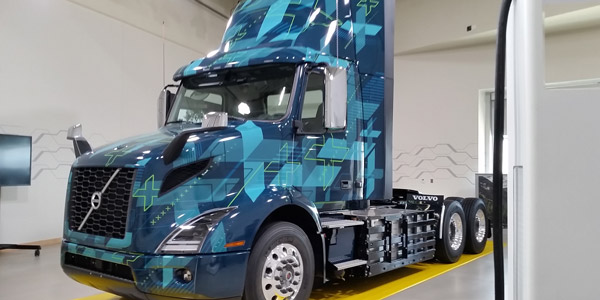
Over the past three years, OEMs have invested heavily in driver-focused equipment benefits—from cozy creature comforts to uptime- and productivity-boosting technology. Today, significant R&D investment is going into the development of electric trucks—probing the possibilities of untested powertrains in hopes of producing a product that meets application needs.
But what does that mean for driver-retention and recruitment equipment features in the future?
“Zero emissions is not just about outside the vehicle—it’s inside the vehicle,” says Brett Pope, director of electric vehicles for Volvo Trucks North America. “So now you have an environment with no emissions, and it’s quieter. That’s a better work environment for the drivers.”
“We are also seeing more and more customers that have a mandate to reduce their carbon footprint or emissions,” added Peter Voorhoeve, president of Volvo Trucks North America, painting a broader picture of electric truck demand.
Volvo Trucks North America came out swinging with the driver-focused VNL, VNR and VNX lineup two years ago and is currently preparing an electric VNR for a 2020 launch.
“If we look in the future a little bit, we are providing a driveline that the customer requires and asks for, and we can also help them with building up their electric business,” Voorhoeve continues, noting that customers will have questions about how to work with electric mobility, with charging, and with their electricity providers—all of which, he says, Volvo will be willing and able to help with.
Voorhoeve highlights the Volvo LIGHTS program as the OEM’s primary way of learning about the electric market and passing that knowledge on to the customer.
LIGHTS stands for Low Impact Green Heavy Transport Solutions, and is a partnership between the Volvo Group, California’s South Coast Air Quality Management District (SCAQMD), and many other partners from the transportation and electrical charging infrastructure industries—60 partners in total, according to Voorhoeve.
“Not only does the LIGHTS program show the impact of an electric truck, but it shows how you can use an electric truck as part of a light impact, green, end-to-end heavy transport solution,” he says.
Pope says that the Volvo Trucks North America is looking into multiple different levels of electric truck services to match customers’ levels of need, once Volvo’s electric trucks are ready.
The first option would be a full-service lease. This, Pope says, can help ease fleets into electrification if they have concerns about the technology. The next step, he says, would include infrastructure.
“This is also where we’re looking providing things such as an e-consultant service,” Pope explains. “As the number of electric trucks in the fleet increases, the customer will need some help with program management. How do you handle the logistics of a large number of trucks? Have you ensured that they’re charged and that they’re ready to go to that next shift? It can become quite complicated.”
The most in-depth level of electrification, Pope says, is what Volvo calls energy as a service, which moves outside the vehicle and the charging infrastructure to include things like solar power generation.
“The large fleets have sustainability targets and could be interested in solar generation,” he says. “With solar generation, you can also look at battery backup. Why battery backup becomes interesting is you can also use that to manage your power demands. So that becomes a cost control method.”














